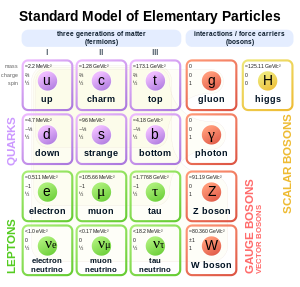 |
| Standardin mallin sisältämät hiukkaset kuva wikimedia |
Kertausta vielä, matkalla ensimmäisten fotonien maailmaan.
Hiukkasfysiikan määritelmä
Particle physics is a branch of physics which studies the nature of particles that are the constituents of what is usually referred to as matter and radiation.
In current understanding, particles are excitations of quantum fields and interact following their dynamics.
Although the word "particle" can be used in reference to many objects (e.g. a proton, a gas particle, or even household dust), the term "particle physics" usually refers to the study of "smallest" particles and the fundamental fields that must be defined in order to explain the observed particles. These cannot be defined by a combination of other fundamental fields.
The current set of fundamental fields and their dynamics are summarized in a theory called the Standard Model, therefore particle physics is largely the study of the Standard Model's particle content and its possible extensions.
wikipedia
Hiukkasten esittelyä
Modern particle physics research is focused on subatomic particles, including
atomic constituents such as electrons, protons, and neutrons (protons and neutrons are composite particles called baryons, made of quarks), produced by radioactive and scattering processes, such as photons, neutrinos, and muons, as well as a wide range of exotic particles.
Dynamics of particles is also governed by quantum mechanics; they exhibit wave–particle duality, displaying particle-like behavior under certain experimental conditions and wave-like behavior in others.
In more technical terms, they are described by quantum state vectors in a Hilbert space, which is also treated in quantum field theory.
Following the convention of particle physicists, the term elementary particles is applied to those particles that are, according to current understanding, presumed to be indivisible and not composed of other particles.
| Types | Generations | Antiparticle | Colors | Total | |
|---|---|---|---|---|---|
| Quarks | 2 | 3 | Pair | 3 | 36 |
| Leptons | 2 | 3 | Pair | None | 12 |
| Gluons | 1 | 1 | Own | 8 | 8 |
| W | 1 | 1 | Pair | None | 2 |
| Z | 1 | 1 | Own | None | 1 |
| Photon | 1 | 1 | Own | None | 1 |
| Higgs | 1 | 1 | Own | None | 1 |
| Total | 61 | ||||
Standari malli - kohta tieteen eilispäivää!
All particles, and their interactions observed to date, can be described almost entirely by a quantum field theory called the Standard Model.
All particles, and their interactions observed to date, can be described almost entirely by a quantum field theory called the Standard Model.
The Standard Model, as currently formulated, has 61 elementary particles.
Those elementary particles can combine to form composite particles, accounting for the hundreds of other species of particles that have been discovered since the 1960s.The Standard Model has been found to agree with almost all the experimental tests conducted to date.However, most particle physicists believe that it is an incomplete description of nature, and that a more fundamental theory awaits discovery (See Theory of Everything). In recent years, measurements of neutrino mass have provided the first experimental deviations from the Standard Model.lue koko artikkeli wikipediasta
Erinomainen johdanto aiheeseen
Hiukkasfysiikan näkemysten edes alustavassa ymmärtämisessä minulle on ollut todella suureksi avuksi jo aiemmin mainitsemani sivusto
Particle Adventure
Selasin tuota sivustoa 'Particle Adventure' - kunnes alkoi silmissä pyörimään. Vai että avaruuden täyttää Higgsin kenttä, jonka vaikutus hiukkasiin ilmenee massana... Kyllä siitä Higgsin bosonista oli jotain lukenut, mutta että kentän vaikutus ilmenee massana. Ellei kenttä vaikuttaisi, ei olisi massaa ... Valehtelisin jos sanoisin että ymmärrän
VastaaPoistaeikö olekin hienosti tehdyt sivut!
PoistaJossain Suomen yliopistossa taisivat julkaista suomenkielisena käännöksenä. Mutta alkuteksti on aina parhaiten ajan tasalla ja luotettavin.
Jumalamme matemaattinen lahjakkuus näkyy taas - ihmiset ovat joutuneet kehittämään aivan uutta terminologiaa ja menetelmiä hiukkasfysiikassa, nyt puhutaan väreistä!